The Lutheran Immigration and Refugee Service (LIRS) is a nonprofit organization dedicated to providing service for immigrants and refugees facing persecution. Motivated by their faith, they have developed service programs, organizations, and influenced public policy (Lutheran Immigration and Refugee Service, 2019); all of which can be found on their website, www.lirs.org. While the organization’s goal is to serve, the website’s authors communicate using rhetoric to reach their intended audiences, inform them of the organization’s purpose, the genre of the organization, and the context in terms of how it is relevant today. Using rhetoric successfully will allow the LIRS to effectively induce change from their website.
The audience LIRS is trying to reach varies, as it provides multiple opportunities to engage with the organization for different types of people. Donors and volunteers are the primary audiences of the website. This is shown through the buttons on the navigation bar, as the last but brightest button is “DONATE.”

The color and style the button is presented with deviates from the format of the navigation bar. Along the navigation bar, the buttons link to different pages on the website that give insight as to what the organization’s mission and purpose is, how someone can help, donate, and “take action” (Lutheran Immigration and Refugee Service, 2019). The secondary audiences are the refugees and immigrants that have been helped or are seeking help. The reason they are secondary and not primary is because there are more opportunities provided on the website to donate and volunteer than there are to help the refugees and immigrants directly from online. This could be because LIRS assumes that most do not have access to the internet. When the home page is opened, there is a large graphic that reads “Read the stories” and “Share your story,” and provides inspirational accounts of refugee experiences from those they are aiding.
The overall intention of trying to reach these audiences is to persuade viewers to give to their organization whether it be in the form of time and energy, personal accounts, or money. An additional purpose is to inform the public of the power of their faith, as they are a religious-affiliated organization. A portion of the website is dedicated to religious writing, in the form of downloadable prayers or readable sessions about the Lutheran faith. While the site does not directly educate on what the religion is by definition, it provides perspectives and online sessions to read religious texts written by the authors of the website.
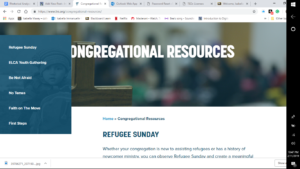
Broadly defined, the LIRS website is a nonprofit service organization. Beneath a more specific lens, it is a religious-affiliated organization that focuses on aiding immigrants, refugees, and other asylum-seekers. Key features that tell the audience it belongs to the nonprofit genre of websites are its spatial, linguistic, and visual modes. This multimodal text uses a spatial organization with a one-column style of text and linguistics in English and the option to read in Spanish.
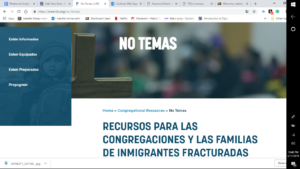
It is not meant to be complicated or require deep analysis to find its purpose and resources, and is made easy-to-read to pertain to both English and non-english speakers based on the context of its website is a nonprofit service to immigrants and refugees from other countries. The spacing and format of the website also reflect other nonprofit websites, with features such as large, contrasting colors and letters as well as large graphics that requires one to scroll throughout the page to read more (but not dense) content. The options on the navigation bar are listed left-to-right for simplicity, and the use of calm, cool colors against a vast amount of whitespace provides a more calm and friendly tone set by the site, despite the context of the topic to be more demanding.
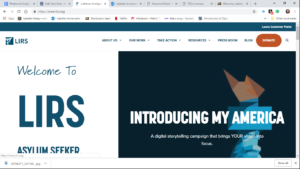
In a heating political climate in which “immigration” is now a household and sensitive topic, this website exists within the context that it is relevant to today’s current issues of immigration to the U.S. It even includes a newsletter that details these issues.
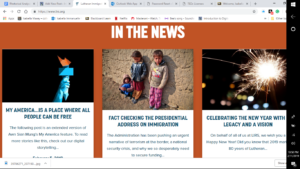
Several years ago, when the internet was recently invented, this website would not have existed because online media was incredibly new as well as an untouched frontier. In this present context, one can simply use a search engine to find a site like LIRS’s to learn more about the issue. The medium is online to provide this convenience, ease, and efficiency for both the LIRS and their audience. The social and cultural connotations of the text are that while immigration is a hot topic that demands attention in the media, it is also often seen as a threat to inhabitants of the U.S., depending on how the information is presented.
Beneath the “ABOUT US” tab of the navigation bar, there is a link to a page titled “OUR LEADERSHIP.” This page of the LIRS website gives the names of the Executive Committee of LIRS, At-Large Members, and Staff Leaders (Lutheran Immigration and Refugee Service, 2019).
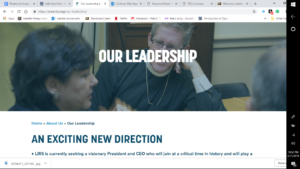
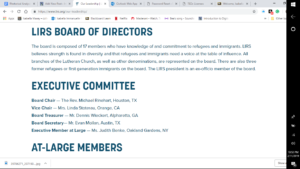
There are no direct names of the author(s) or creator(s) of the website, therefore one can assume that the names that comprise the lists of LIRS’ leadership page played key roles in the development of the website. In essence, the website is a portfolio of the work done by the LIRS, which is compiled by the different experiences and works accomplished by all members. Therefore, the author of the website is the organization as a whole.
The Lutheran Immigration and Refugee Service organization has successfully applied rhetoric to their multimodal website, www.lirs.org. They were able to communicate the need and desire for change to the public, and reach their audience based on the accounts of experiences from refugees, volunteers, and donors. They have made known their purpose of persuading the audience to give through the literal written text asking to give, as well as giving clear options to do so throughout the website. They have made known to their audience that they are of a nonprofit genre through the formatting of the website as well as the content of the text communicated. The context of the website also communicates the relevance of their message, motivating the audience as well as permitting them to take the required action now. While there was no clear name given, the author of the website can be concluded as the organization itself, glorifying its purpose rather than the faces behind it. These are all factors that have allowed LIRS to induce change through their website.
VIDEO ANALYSIS: https://drive.google.com/open?id=1aAoW1iJK3V3iBWZ2ylANBD41IxSo28ZU
Citation
“Lutheran Immigration and Refugee Service.” LIRS, 9 Feb. 2019, www.lirs.org/.